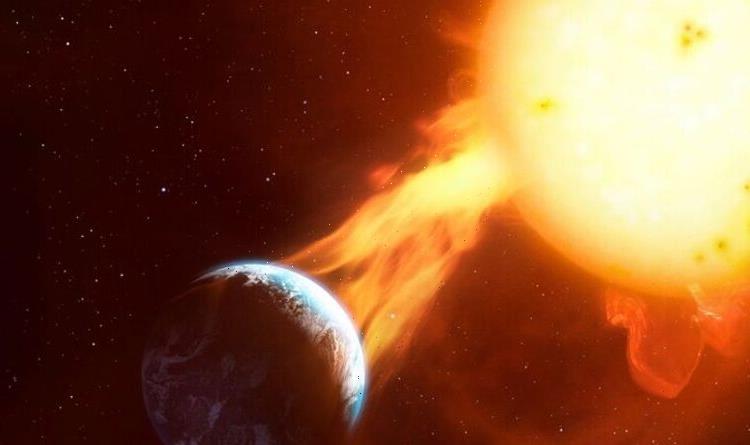Solar Storm: Weather chart shows global movement
We use your sign-up to provide content in ways you’ve consented to and to improve our understanding of you. This may include adverts from us and 3rd parties based on our understanding. You can unsubscribe at any time. More info
One of the most powerful forms of solar storm, a coronal mass ejection (CME), occurs when the Sun belches out a cloud of charged particles and electromagnetic fluctuations. This CME, which began striking the Earth yesterday, was released from the Sun’s surface on March 11 at some 373 miles per second, accompanied by the flash of a solar flare. According to researchers, it was not the intensity of this emission but its long duration which led them to anticipate a moderate geomagnetic storm on Earth — with energy being expelled into space over a period of 12 hours.
According to the US Space Weather Prediction Center, the storm has been classified as a G2 event on the five-point G-scale, in which G1 is the weakest and G5 the most severe.
In a post published yesterday, they added: “Disturbed conditions are expected to continue throughout the day and into tomorrow [Monday].”
A G2 storm, the experts explained, can cause mild power grid fluctuations, interference with satellite operations in low-Earth orbit and the disruption of high frequency radio signals at higher latitudes.
The latter effect was certainly seen. As space weather expert Dr Tamitha Skov tweeted: “Many reports of impacted amateur radio propagation today.
“The rather sporadic magnetic field in this solar storm is really disrupting the bands. Switching to lower frequencies might help. They are less impacted by solar storms, especially on Earth’s nightside.”


The most obvious effect of the CME, however, came in how it boosted the aurora borealis and australis, the natural light shows generated when particles from the solar wind excite atoms in Earth’s upper atmosphere, making them glow.
The aurora form curtains of light that follow the geomagnetic field lines — and appear in different colours depending on which atoms are being excited.
The two primary gases in the Earth’s atmosphere are oxygen, which emits a greenish light, and nitrogen, which appears in hues of blue, pink and purple.
As Dr Skov highlighted, stunning auroral displays were seen in such locations as Australia, Norway, Scotland and Sweden.
She said: “Wow. Not only has the solar storm arrived early, but its initial impact hit hard enough to cause aurora to brighten to a point that it could compete with a nearly full moon and the bright lights over Stockholm!”


According to experts with SpaceWeather.com, the storm is now subsiding. While there is the possibility that conditions could flare up again as the Earth moves through the magnetised wake of the CME, such will likely only reach G1-class conditions.
They added: “Auroras will retreat to the Arctic Circle on March 14.”
Alongside this weekend’s enhanced auroral light shows, the CME also caused interference with the Earth’s geomagnetic field — inducing, for example, electric currents within the soil of northern Norway.
Citizen scientist Rob Stammes of the Lofoten Islands told SpaceWeather.com: “Today, March 13, just before 11:00 UTC the expected shockwave arrived on my instruments.
“Variation on my magnetometer and ground current instrument. Also a ripple or ionisation on my VLF receiver, which is remarkable.”
DON’T MISS:
‘US will enter war’- Putin sent dire warning over ‘next’ deadly move [ANALYSIS]
Energy crisis: PM handed ‘cake and eat it’ plan to CUT Russian ties [INSIGHT]
Putin sent horror NATO warning: ‘Severe price’ to pay for Russia [REPORT]

While this weekend’s solar storm was only “moderate” in intensity, some experts fear the impact that a G5 event might one day have on modern society.
A coronal mass ejection in the September of 1859 caused the most powerful geomagnetic storm on record — one which scientists refer to as “the Carrington Event”.
The storm affected telegraph networks across Europe and North America, as well as the recently-lain transatlantic link that connected them.
Currents generated in cables by the space weather event reportedly caused telegraph pylons to spark, operators to receive electric shocks and some lines to fail completely.
Other lines, meanwhile, were found to still operate even once their power had been cut, so strong were the electrical currents induced by the storm.
According to a study presented at the Association for Computing Machinery’s annual SIGCOMM conference last year, a large solar storm like the Carrington Event could have the potential to cripple the Internet for weeks.
Unlike Victorian-era telegraph lines, the fibre optic cables that make up the backbone of the Internet are actually immune to the electromagnetic fluctuations caused by solar storms.
The same cannot be said, however, for the signal boosters that are dotted along undersea cables in order to maintain connections over long distances.
And being underwater, not only are these long-distance cables more vulnerable to the impacts of space weather, but they are also inherently harder to access for repairs.
Astrophysicists predict that there is a 1.6–12 percent chance a solar storm powerful enough to cause catastrophic disruption to modern society will strike the earth in the next 10 years.
Source: Read Full Article
